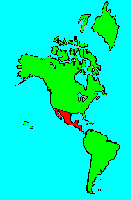SPECIES INFO
Quetzal (Pharomachrus mocinno) is found from southern Mexico to Costa Rica. Recent research has shown that this bird migrates through various elevations to feed on various fruits in the proper season. The dependence upon numerous species of trees at different altitudes provides a challenge for conservationists to save this magnificent species. Costa Rica has already set aside nature preserves across various altitudes to help with its preservation.
The Quetzal has been called the most beautiful bird in the world. It is primarily green with a red breast and is only about 14 inches long. However, in breeding males the long tail plumes add up to two additional feet to its length. Its feathers can be carefully removed and the birds released to grow additional feathers. It was worshipped by ancient Indians.
There are two subspecies. The nominate subspecies is found from southern Mexico to northern Nicaragua. The subspecies costaricensis is found from Costa Rica to western Panama. BR>
Garrigues noted in 2007 that this quetzal was fairly common in the highlands of central Costa Rica. However, this editor notes those highlands are a very small geographical area. Consequently, we give this a threatened life form status.Trogons (Group Trogoninae) are comprised of 25 species of highly-colored birds. This group is found in the New World. Although one species can be found in the extreme southern United States, most species are of a tropical nature.
Trogons (Order Trogoniformes) are an order of 39 birds found in the tropics of the New World, Africa, and Indo-Australia. There is one family in this order. The Quetzal, a central America species, is regarded as one of the world's most beautiful birds. (Some authors divide this family into several partitions. The Apaloderma group(3 species) is native to Africa. The Trogon group(25 species with many subspecies) is native to the New World. The Harpactes(11 species) group is found in the SE Asia and south into Indonesia and the Philippines.
Trogons are usually found near the top of rainforests flying around and catching flying insects, and also catching arboreal crawling insects. The first and second toes point backward, and the third and fourth toes point forward.
Aves contains about 8,650 different species of living birds known to science. Each year about one new species is discovered in some remote rain forest or remote island. In addition, scientists have been raising many subspecies to full species status which may raise the species count to 10,000. Birdlife recognizes 10,027 species as of 2011.
However, each year about one species goes extinct. The rate of extinction is increasing, and the rate of new discovery is decreasing, so that the number of bird species will soon begin to decline rapidly. Although different taxonomists would organize the birds differently, there are approximately twenty-seven orders of birds. These orders are broken down into about one hundred and fifty-five different families.
Recent research of the genetic structure of some of the shore birds and owls would indicate that the present organization of orders and families should have some modification.
The birds are a worldwide group of animals that are characterized by having the front limbs modified into wings that are used for flying. Perhaps the most unique feature of the birds is the feathers. These feathers are made up of a central support called a quill and a series of small filaments that are hooked together as barbs.
For many years it was believed that Archaeopteryx discovered in Bavaria was the oldest bird from about 150 million years ago. However, in l986, Sankar Chattterjee, a Texas paleontologist, reportedly discovered a bird in the genus Protoavis that lived about 225 million years ago.
When this project was begun in 1978, we used Austin & Singer for bird taxonomy. Since then, we have adopted many changes, but have kept some older concepts that are still found widely in the literature. Recently, we have used Clements and Howard & Moore. Very recently, we have used Monroe and Sibley for the higher taxonomy of the perching birds.
Backboned Animals (Phylum Chordata) are the most advanced group of animals on earth. These animals are characterized by having a spinal cord or backbone. Most members have a clearly defined brain that controls the organism through a spinal cord. Fish, amphibians, reptiles, birds, and mammals are in this phylum.
Currently, some taxonomists believe that the fish should be divided into two groups (sharks and regular fishes) and that there are some other primitive groups in the phylum such as hagfish or lampreys.
Animal Kingdom contains numerous organisms that feed on other animals or plants. Included in the animal kingdom are the lower marine invertebrates such as sponges and corals, the jointed legged animals such as insects and spiders, and the backboned animals such as fish, amphibians, reptiles, birds, and mammals.



